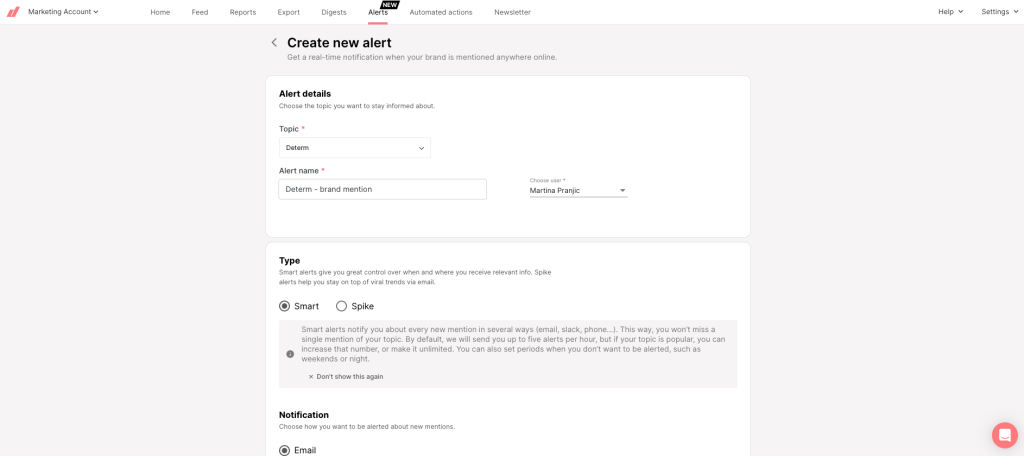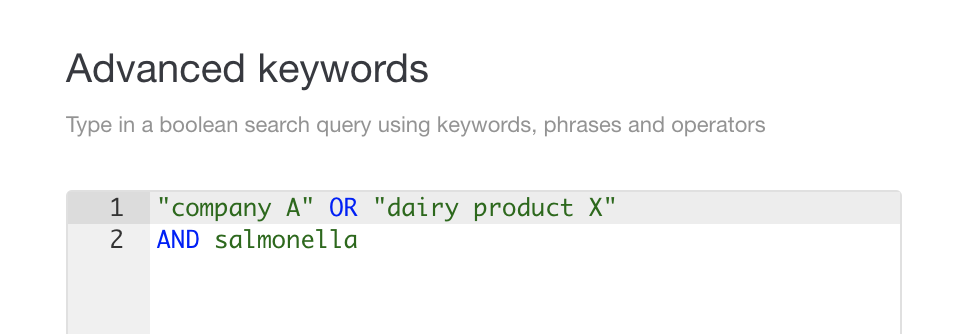Is a crisis communications plan really necessary? Well, if you’re here, you know it is. You know there’s no such a thing as being safely sheltered in an impenetrable, crisis-repellent tower. You know that, in reality, companies (small or big) are more like Jenga – one wrong move and everything falls apart. Not to sound terribly dramatic, but I think the possibility of a PR crisis warrants the sentiment.
And the possibility of a PR crisis certainly warrants a hawk-eye focus on crisis monitoring.
We live in a world of peak social media activity, consumer empowerment, and easily accessible and shareable information. This is why companies constantly need to be aware, vigilant, and empathetic to keep up with that world.
💡 Read Crisis Management 101: How to Save Your Business When a Crisis Strikes
They need to be aware of any theoretical crisis they may encounter, vigilant about monitoring its progress, and empathetic in delivering a response. Simply put, companies shouldn’t cower from the possibility of a crisis, but rather plan for it.
That’s why this guide will take you through all the important elements of a crisis management plan and provide examples.
Prepare a Crisis Communication Plan Outline
A research conducted by Clutch, a ratings and reviews company, has found that long-term brand reputation depends on how and when a company responds to a PR crisis. In fact, this research has shown that brands (e.g. United Airlines) who wait to react and/or react poorly to a crisis, have a higher chance of losing customers.
Take Boeing, for instance. As PR Week reported, Boeing’s average reputation score in January 2020 was -71 (on a scale of -100 to 100, with 0 being neutral).
This massive hit to their brand image comes as a result of numerous incidents and poor crisis handling.
This is why a crisis communication plan outline is a must.
Outlining and preparing a crisis communication plan reduces your response time and improves your approach to delivering a response. The faster you react and take control of the narrative, the better for your brand in the long term.
1. Build a crisis management team
These are the people that are going to create and execute your crisis communication plan. Each member needs to be assigned a specific role. From informing the employees to establishing a relationship with the media outlets.
As such, a crisis management team should include senior executives: CEO, head of PR or CCO, heads of departments, as well as legal counsel.
In the absence of crisis management expertise from your in-house team, it would be a good idea to look into hiring a consultant or an agency specializing in crisis communication and management.
Last, but not least – always include a subject matter expert. Depending on the crisis type, include an employee specializing in the area.
As their first task, a crisis communication team should identify a spokesperson – which leads us to our next step.
Read How to Manage a PR Crisis
2. Name a spokesperson
A spokesperson is essential during a crisis, as that is a person responsible for representing your organization in the outside world. They are the ones getting the information about the company out to the public, your stakeholders, and the media, and controlling the flow of that information. A spokesperson has to make sure to deliver your organization’s message correctly and unambiguously.
Read 7 Corporate Crisis Examples and Ways to Manage Them
That is why a spokesperson should:
- Be trained
- Have good communication skills
- Be empathetic and genuine
- Have in-depth knowledge of the situation
- Be quick and resourceful
- Be authorized to make decisions (regarding the communication process)
A spokesperson should always have an aforementioned crisis management team in place to fall on. This group of people selected due to their expertise and specialty in different aspects of the business stands behind the spokesperson. They need to be available 24/7 in time of crisis, should a spokesperson need advice and information that needs to be relayed to the stakeholders.
3. Identify common crisis scenarios, i.e. anticipate a crisis
You cannot predict the exact crisis that might befall you. However, there are some crisis scenarios that have happened commonly enough around which you can build your crisis communications strategy. Additionally, you have to know your product/service well enough to anticipate possible issues that may arise. As it is, no product or service is perfect and resistant to malfunctioning.
What can be helpful in this situation is performing a premortem analysis.
Best explained by Harvard Business Review, which likens it to a “hypothetical opposite of a [medical] postmortem”, a premortem analysis “comes at the beginning of a project rather than the end, so that the project can be improved rather than autopsied. Unlike a typical critiquing session, in which project team members are asked what might go wrong, the premortem operates on the assumption that the “patient” has died, and so asks what did go wrong. The team members’ task is to generate plausible reasons for the project’s failure.”

So, in a premortem analysis you would identify the crisis scenarios that might happen, and then treat them as they did happen. Then you begin untangling each scenario. Why did it happen? Think of every possible reason, however credible or far-fetched, that might have led to the crisis. Then use the gathered information to adjust and improve your crisis response accordingly.
The crisis got out of control because you didn’t react immediately? Have a statement prepared to go out the second you get wind of a problem and take control of the narrative.
The CEO spoke out of turn and made it worse? Again, have prepared statements and make sure that anything he/she communicates goes through a crisis management team first.
You weren’t transparent from the beginning and got caught in a lie? Mark transparency as a key factor in your response.
Doing a premortem analysis may condition you to recognize the first signs of trouble, and may eliminate any need for a postmortem. So, make sure to include it in your crisis communications plan.
Common crisis types & crisis communications plan examples
Below are some crisis scenarios that happen often enough to warrant their own categories and examples. Knowing what to look out for can only facilitate creating an effective crisis communications plan.
#1 Tech crisis
We live in a tech-dominated world, and as such a technological crisis is not something easily overlooked. As it is, much of day-to-day business operations are dependent on technology. So, when it crashes all hell breaks loose, especially for software companies. Hardware breakdowns, software malfunctions – it’s all something to keep a watchful eye on.
Tech crisis communications plan example: Heathrow airport
In 2020, London’s Heathrow faced flight disruptions due to technical issues that affected their departure boards and self-check systems. What followed was utter chaos according to passengers’ testimonials. Some people’s flights were delayed, some missed their flights entirely and people generally had little to no information regarding their flights. Or, if they did, it turned out to be misinformation.

As the affected airline, British Airways stated that the flight cancellations were a combined result of Heathrow’s IT issues and disruption caused by Storm Dennis. In one response to a tweet from a customer, they said: “We’re aware Heathrow Airport is currently experiencing a technical issue that is impacting some of their IT systems across the airport, affecting a number of airlines. We are working with them to resolve the issue as a priority and apologize for the delay to our customers.”
This may also serve as an example of how natural occurrences, such as storms, may call for crisis response. And that leads us to our next common crisis type – natural crisis.
#2 Natural crisis
Wildfires, floods, earthquakes, hurricanes, to name a few, can considerably affect a business. That’s why, if your offices are located in an area that’s exposed to extreme weather conditions, you have to be aware and proactive. You need to keep weather conditions in mind even when building the offices, so as to make them resilient to a natural disaster striking. In the event of a natural crisis affecting your business and making your offices uninhabitable – you need to have a back-up plan for your business operations.
#3 Product recall
You have to plan for a situation that may possibly involve a product defect or safety concerns. In the event of this happening, you have to pull your product from the market. It’s in the best interest of your customers and yourself. In this situation, it is important you react quickly and in a way that addresses customers’ concerns and protects the company image.
Product recall crisis communications plan example: Tylenol
Enter the very well-known ‘82 case of a cyanide-laced Tylenol. Today a lesson in effective crisis communication planning, back then it was a trying period for Chicago citizens and Johnson & Johnson.
In 1982, seven people from the Chicago area were killed after taking cyanide-laced Tylenol capsules. FDA officials hypothesized that the killer bought Tylenol over the counter, injected cyanide into the capsules, resealed the bottles, and then sneaked them back onto the store’s shelves. To this day unsolved mystery of who was behind the killings and why could’ve put the blame entirely on Tylenol. Subsequently, Johnson & Johnson, its parent company, would’ve been blamed, too. However, in a move that cost them millions of dollars, they pulled all of the product from shelves. They even urged the public not to take Tylenol. Additionally, they established a hotline for worried customers looking for information and answers. In the end – winning back the public’s sympathy and reestablishing its brand.

Not to mention, this crisis was a reason why the FDA mandated tamper-resistant packaging for medicines. Which then changed the way we take the pills today.
LESSONS:
Be transparent.
Take note of and address consumer concerns.
#3 Staff crisis
Staff crises generally pertain to the employees’ involvement in unethical or illegal misconduct. In this situation, you have to take disciplinary action, as well as address the public and stakeholders to take a stand on the situation.
A crisis of this kind happened to a coffee giant, Starbucks.
Starbucks crisis communications plan: Words, but also actions
It happened in 2018 when Starbucks’ Philadelphia store manager called the police on two black men for allegedly trespassing. Turns out, the two men were simply waiting for their friend to arrive before ordering and were subject to racism that is still so deeply ingrained in the US (but also the whole world).
The Starbucks CEO did react immediately, issuing an apology a few hours after the incident happened. He stated that Starbucks “stands firmly against discrimination and racial profiling”. Additionally, he promised to look into the situation and circumstances that led to it, as well as make any necessary changes to their practices that would prevent anything like that from happening again. Although he tried to portray a very apologetic tone through his statements, people felt it wasn’t enough.
It didn’t help Starbucks that the whole situation was captured on camera and became available to the wider public. The public then started protesting, with people holding up signs like the one proclaiming “too little, too latte”.

However, Starbucks didn’t want the dust to settle on empty promises. The Starbucks’ then executive chairman Howard Schultz closed 8,000 locations to put 175,000 employees through racial bias training. They aimed to create more awareness around how racial bias works and help employees apply that awareness on the job.
LESSONS:
Actions speak louder than words.
Take responsibility.
#4 Sudden crisis
There are some crises you absolutely can not predict and have no control over. One such example is KFC’s chicken shortage crisis that caused them to temporarily close down their UK restaurants. However, KFC handled it exceptionally well. They owned up to their mistake and addressed it in a way that stayed true to their brand voice.
Crisis communications plan example: When KFC admitted to FCKing up
KFC encountered a bit of an unfortunate problem back in 2018. A fast-food chain restaurant famous for its Kentucky fried chicken ironically ran out of chicken in the UK chain.
It was a logistics management nightmare. KFC had recently switched to a new logistics partner, DHL, who failed to deliver the chicken from the warehouses to restaurants.
Lack of contingency planning led to a chicken shortage in their UK restaurants. That then forced KFC to close down shop for a while. However, KFC quickly owned up to their mistake and took to social media to try and bring humor to the situation.
“The chicken crossed the road”, was the fast-food chain’s response, “just not to our restaurants”.
Along with this headline, they addressed the situation and explained what caused it. After that first “The Colonel is working on it” tweet, they followed it up with more “updates from the colonel”. They even set-up a website amusingly containing crossed-the-road in the URL. Lastly, they created a hashtag #wheresmychicken to keep their customers informed.
Additionally, KFC posted a few Q&A style images on Twitter under a caption “There’s gossip in the hen house, here are the facts…”.
Last, but not least – KFC ran an ad apologizing for the shortage in their own unique way.
Through it all, they stayed true to their brand voice whilst putting emphasis on keeping their customers informed through the whole process – a real example of effective crisis communication planning.
LESSONS:
Own up to your mistake.
Respond quickly.
Keep your audience informed.
Keep in mind
Not every issue your company encounters is a crisis. Keep this at the forefront of your mind when identifying a crisis.
How can you differentiate one from the other?
Determine the magnitude of the problem: is it really a crisis or is it something that’ll blow over? Establish the gravity and urgency of the problem. Take into account the influence of a person (or people) behind the problem. How big is their reach? Big enough to reach a great number of people or something containable to a small audience?
These are all questions you need to ask yourself before deciding an event is a crisis.
4. Identify and address stakeholders
It’s important to know who are the people affected by the crisis. Who needs to be informed about it happening – be it internally or externally? The best way you can go about this is to create a list of these people. That list will most likely include your employees, investors and partners, your customers, and the general public (such as social media users and followers).
These are all the people that need to be addressed and informed about the crisis.
Adjust your communication strategy accordingly
Depending on the crisis type, you need to adapt your crisis communications strategy to the affected stakeholders. Who the crisis affects, in what way, and in what intensity needs to be clearly defined and communicated.
For instance, if it’s an event that affects the environment, the communication clearly needs to be directed primarily to the local, affected population. They need to be made aware of the exact circumstances surrounding the event, steps that are being taken to manage the crisis, and possible repercussions they might face.
5. Establish crisis monitoring & alerts systems
This is called being proactive and taking necessary preventive steps. While it’s true that you can’t predict every single crisis, some are easier to detect than others. Especially if you have set up a monitoring and alerts system.
Some issues you may anticipate happening. Especially if they’re closely related to your product/service or industry. These are the problems that happen commonly or have happened to you before and you want to prevent them from happening again.
Some you may not specifically anticipate. However, if you’re monitoring your company’s online presence you can be alerted of unusual online activity. These usually point to something happening that’s caught social media users’ and media outlets’ attention.
So, what are these monitoring & alerts systems that can help you detect possible crisis situations?
Most often, those are media monitoring or social listening tools. Media monitoring tools are specifically intended for scouring the internet for brand mentions. As such, there are many ways media monitoring can help you with crisis communication.
Here are a few features you’ll want to take notice of when it comes to crisis communication:
Topic set-up
This is probably the most important part, as the success of media monitoring depends on the way you set up keywords to track. Is it going to be just your brand name? Your CEO’s name or other executives’ names? Common complaints? All three?
It’s imperative you think long and hard when thinking of keywords to track.
Alerts
Once you set up your topics, you absolutely want to make sure to turn on alerts. These notifications will inform you whenever there is a spike in your mentions. For instance, when an unusual amount of online chatter is happening around your topics. It is often an indicator of viral content – be it an impending crisis or positive feedback.

Test out these crisis alert features yourself! Try Determ for real-time crisis monitoring and get ahead of these pesky crisis situations.
Digests
Digests provide you with an overview of your mentions. You can set them up for a daily or weekly update, and catch up on everything that’s been talked about on the topic of your set-up topics.
How does it help prevent crises in real life?
A good example is preventing fake and malicious news from spreading, especially if it’s happening in a different country.
Let’s take a food production company A as an example. Their dairy product line has a close competitor B in another country. To try and damage their reputation, company B spreads fake news about a case of salmonella in company A’s dairy products. However, if company A kept a close eye on news outlets in every country their product is sold in and had alerts on, they would immediately become aware of the situation. Instead of allowing it to spread, they could quickly issue a statement explaining the situation and prevent further damage from happening.

On the other hand, if there really was a case of salmonella that would necessitate them to pull their product from the stores, that’d be less of a case of preventing fake news and more a legitimate customer health concern.
Instead of having to wait for an intermediary to deliver the information to you, media monitoring tools will inform you immediately. It’s just a matter of setting up your topic to contain salmonella-related keywords or tracking specific websites (e.g. organizations or centers for disease prevention and control). As soon as there’s a concern, you’ll be among the first to know.
6. Anticipate stakeholders’ questions and provide answers
If a crisis does hit, what do you predict the frequently asked questions would be? Create a list with every question you can think of and then answer those questions. As a result, you’ll have a set of answers ready for when your stakeholders (from your employees to your customers) really do ask them.
Better yet, you can use those to set up a website where the public can find answers to all their questions and all information related to an issue at hand (updated regularly).
7. Create a social media action plan
According to research conducted by Clutch:
52% of consumers spend the most time using social media, allowing for opinions to change and news to travel quickly.
More than three-quarters of people (76%) expect companies to respond to comments on social media, and 83% expect brands to respond to these comments within a day or less.
Nearly half of social media users (45%) would view a brand more positively if it responded to negative comments on social media.
Social media is important. What’s more, it’s the best way to directly communicate with your customers, but also any other social media user talking about your company.
It provides you with an opportunity to interact with your customers, humanize your brand, and make you seem more approachable.
Not using it properly in a time of crisis is at the very least a waste, at most completely unacceptable.
If you have a direct way to communicate your message – why not use it? Control the narrative yourself by directly addressing any questions and negative comments.
You need to know how you’re going to approach a crisis on social media. In what tone and with what message? Always be sure to stay true to your brand voice, be genuine in your delivery, and admit to your mistakes.
Use your social listening tool here, too. It’s an excellent way of keeping up with all of the negative comments and answering them immediately and consistently. You can keep track of specific keywords related to a crisis in question, track mentions of your brand name or names of people involved in the crisis.
8. Assess risk potential
However well thought out your crisis communication plan is, you always have to plan for potential risks. Always think of things that might go wrong and plan for them in advance. Have contingencies set in place.
Conclusion
There you have it – a step-by-step guide to establishing an effective crisis communications plan. Only 53% of Fortune 500 companies have a crisis communications plan in place. Don’t be one of them – use our guide to be proactive in your crisis strategy and management planning. Don’t wait for a crisis to strike to start scrambling for an appropriate solution.